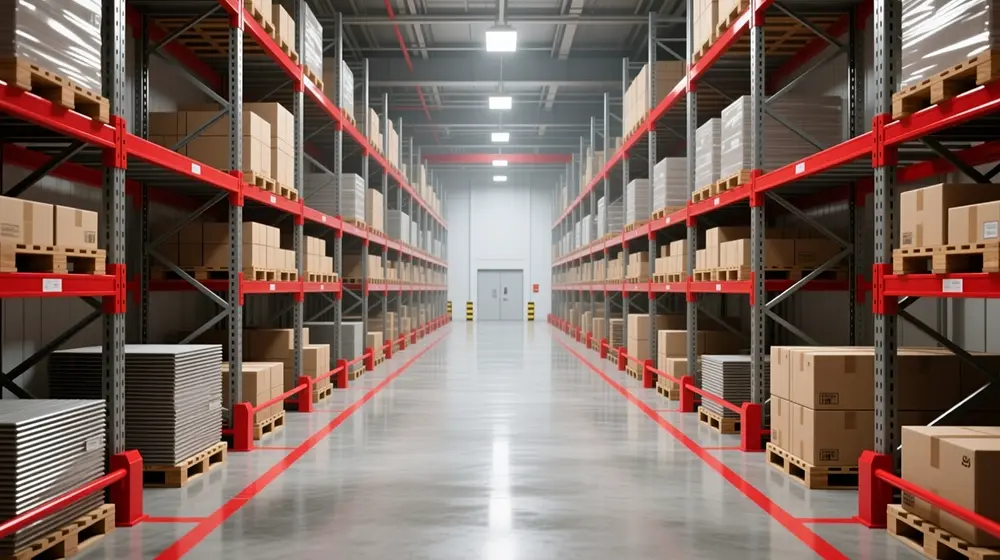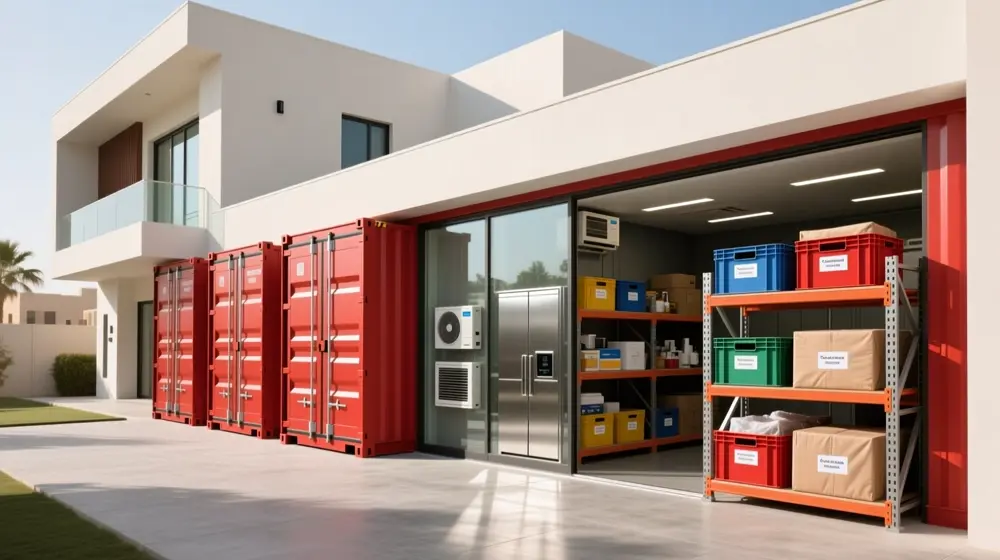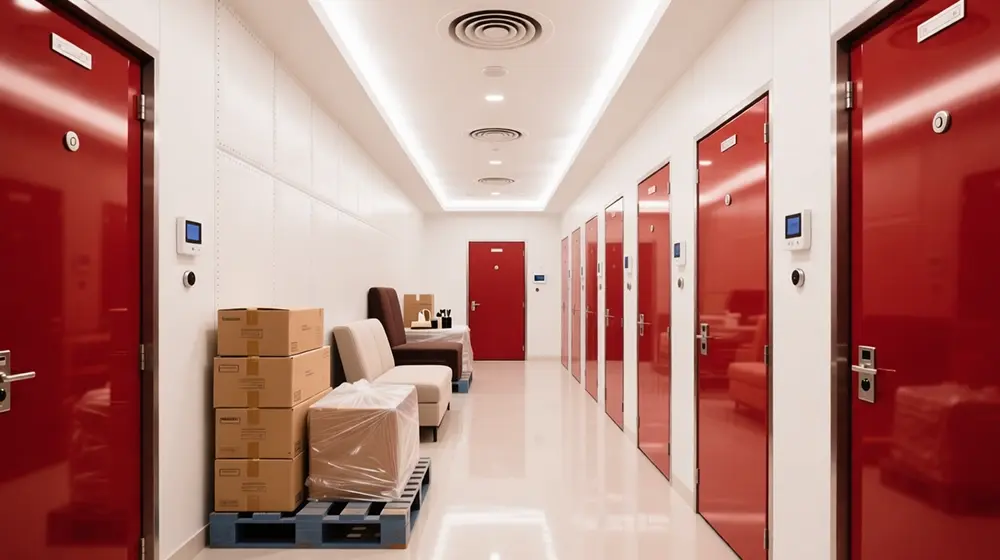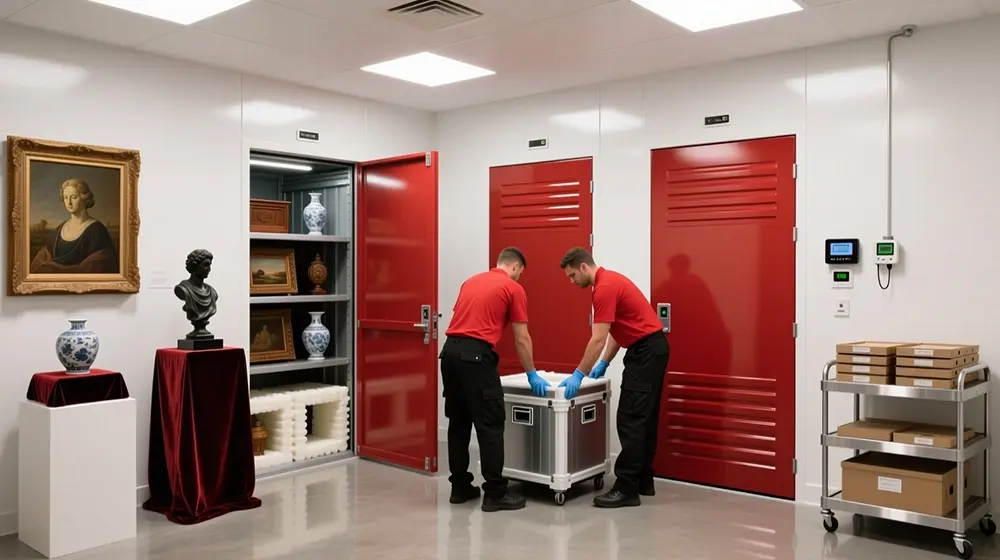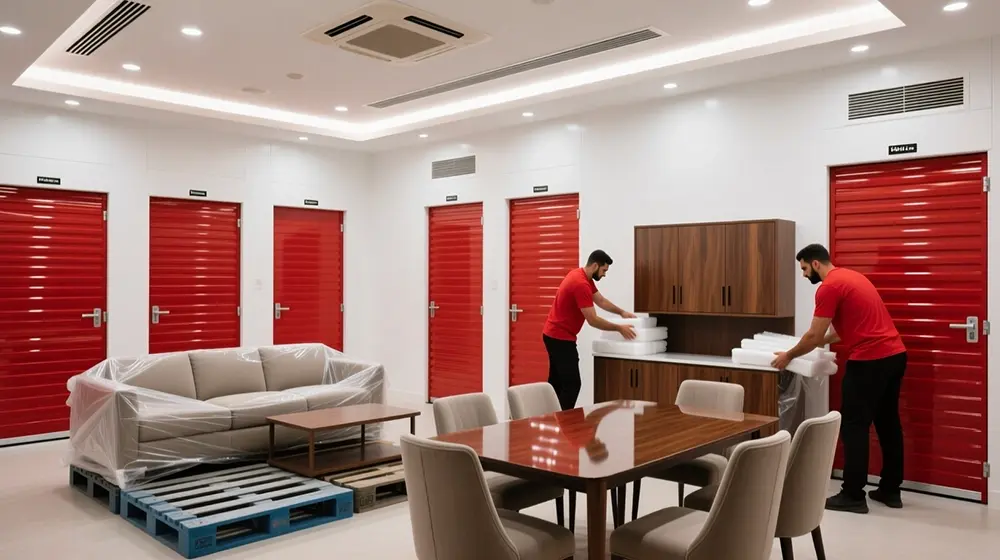UAE e-commerce is expanding quickly and is on track to generate roughly $8 billion in online retail sales by 2025, driven by near-universal internet and smartphone penetration and pro-digital policy. Micro-warehousing—small, near-customer fulfillment sites that compress delivery time—has become a core logistics tactic, with the UAE micro-fulfillment market projected to reach $460.9 million by 2030 (CAGR ~29.8%). These urban-proximate hubs align with rising same-day/next-day expectations and recent network investments (e.g., Amazon’s new technology-enabled facility in KEZAD, Abu Dhabi, built to speed processing and same-day service).
Tight industrial fundamentals amplify the shift: warehouse rents rose sharply in Q2 2025—Dubai up ~19.9% and Abu Dhabi up ~22.4%—pushing retailers to reconfigure footprints toward smaller, flexible units closer to demand while holding bulk stock in peripheral sites. This article examines: market size and growth, drivers of micro-warehousing, impacts on storage mix and preferred unit sizes, and operational challenges and opportunities for retailers, operators, and investors in the UAE. For source depth, see the U.S. International Trade Administration’s UAE e-commerce guide for market context, McKinsey’s Gulf retail outlook for demand signals, Grand View Research’s UAE micro-fulfillment forecast for sizing, and JLL’s UAE industrial updates for cost and supply conditions.
Also Read : The Evolving Role of Warehouses in Dubai’s E-Commerce and Logistics Sector
UAE Warehousing & Micro-Fulfillment Market Size & Forecasts
- The UAE logistics and warehousing sector continues to expand, reflecting strong trade flows and e-commerce adoption. According to Grand View Research, the warehousing market in the UAE generated USD 21.8 billion in 2024 and is projected to grow to USD 34.2 billion by 2030, representing a steady CAGR of ~7.8% through 2025-2030.
- Within this broader market, micro-fulfillment is the fastest-growing segment. These smaller, tech-enabled hubs—typically located closer to major demand centers in Dubai, Abu Dhabi, and Sharjah—allow faster picking, packing, and same-day dispatch. The UAE’s micro-fulfillment market was valued at USD 74.2 million in 2023 and is forecast to reach USD 460.9 million by 2030, reflecting an impressive ~29.8% CAGR, driven by demand for near-customer inventory and last-mile efficiency.
- Complementing this trend, the self-storage industry in the UAE is also experiencing growth. Market revenue stood at USD 602.5 million in 2024 and is projected to reach USD 859.2 million by 2030 (CAGR ~6.3%). Medium-sized units (50-150 sq ft) currently generate the most revenue, but large units are the fastest-growing category as businesses seek overflow capacity for bulk inventory, seasonal stock, and returns processing.
Key Drivers & Trends Fueling Micro-Warehousing
E-commerce & Last-Mile Delivery Demands
- A PwC Middle East survey reports that 65% of UAE shoppers prefer online platforms offering same-day delivery, which incentivizes businesses to locate inventory closer to urban centers.
- Amazon’s new high-tech fulfilment centre in KEZAD (Abu Dhabi) was specifically built to cut processing times and enable same-day delivery, showing investment by large e-commerce players in micro-warehousing infrastructure.
Real Estate & Cost Pressures
- KEZAD Group announced plans to boost warehousing capacity by 250,000 sq m with an investment of AED 621 million, reflecting demand for more logistics space and prebuilt warehouses in industrial zones.
- Since Q3 2022, KEZAD delivered over 270,000 sq m of additional industrial & logistics space, with leased areas seeing ~66% uptake, suggesting demand is outpacing supply in prime zones.
Flexible Demand & Inventory Patterns
- During high-sales seasons & events (e.g. Ramadan, “Dubai Shopping Festival”), e-commerce order volumes spike, which increases pressure on delivery speeds, returns handling, and temporary buffer inventory, making flexible and small-scale warehousing essential.
- SMEs and small online merchants prefer smaller, flexible storage or fulfillment units to avoid the risk and cost of under-used large warehouses; this is backed by statements in market reports that express delivery and fulfillment firms are growing their last-mile networks to include many smaller hubs.
Technology & Automation Adoption
- The emergence of Grade A warehouse facilities in Dubai and elsewhere is increasingly tied to technology integration—automation, efficient layout, real-time inventory tracking—to meet the demands of fast turnaround.
- Micro-warehouses benefit from a smaller footprint and dense configurations (e.g., vertical storage, narrow aisles) to maximize usable volume; real estate developers are building prebuilt industrial units with such specifications to attract tenants. KEZAD’s recent announcements demonstrate this trend.
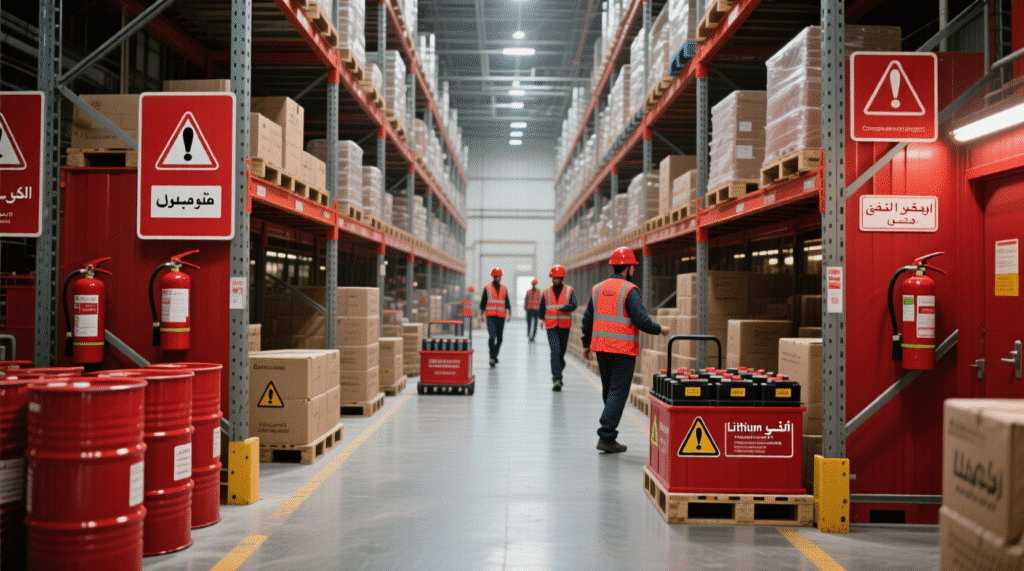
Storage Mix & Unit Sizes: What Is Changing?
Dominant Unit Size Segments
- In the UAE self-storage market, medium-sized units (≈ 2-10 m²) generated the largest revenue share in 2024, driven by demand from apartment movers, seasonal storage, and short-term storage users.
- Large units (≈ 10-30 m² and above) are the fastest-growing unit size segment from 2025-2030, catering to bulk inventory, overflow stock, SME storage needs, and villa relocations.
Micro-Warehouse Footprint & Layout Preferences
- Micro-fulfillment and micro-warehousing sites in the UAE often occupy hundreds to a few thousand square feet rather than tens of thousands. These layouts emphasize high shelving, efficient pick/pack flows, and compact storage for fast movers. Although exact square-foot breakdowns are proprietary, the trend is confirmed in the “UAE Self-Storage Market Map” from ESelf Storage UAE, which notes that medium-units dominate now while large units are growing fastest.
- In the cold-chain and refrigerated warehousing space, the public/refrigerated warehousing segment is growing rapidly, and many new cold storage facilities are being configured with multi-temperature zones, though ambient warehousing still dominates overall warehousing demand.
Pricing & Unit Cost Differentiation by Size & Location
- According to ESelf Storage UAE’s unit economics data, medium units remain the core revenue drivers, reflecting that small lockers or small rooms cost less but generate less revenue, while large units command higher rates and are increasingly sought after by commercial and bulk inventory users.
- The UAE Warehousing Market Outlook by Nexdigm confirms that general warehousing (ambient) is still the largest segment in warehousing revenue, but specialized warehousing like cold storage is the fastest growing, which also raises per-unit costs in those specialized segments.
Operational & Layout Implications
- Zoning inside micro-warehouses: To speed picking and reduce cross-traffic, operations are dividing zones for fast-moving SKUs, returns, packaging, staging, and overflow. This improves throughput and reduces labor waste. This is cited as a solution in the UAE warehouse challenges reports, where inefficient flows cause delays.
- Use of narrow-aisle racks, vertical & modular shelving: Urban distribution centers increasingly adopt very narrow aisle (VNA) racking systems in UAE and GCC to maximize cube utilization. VNA systems allow up to ~50% more storage in the same floor footprint. GlobeNewswire reports VNA, mobile shelving, and vertical layouts are trending strongly.
- Example: SSI Schaefer installed a VNA system in KEZAD for cold-chain storage to improve space utilization and maintain environmental controls.
- Local racking providers like ATCO Lift or StorageWorks offer narrow aisle, VNA pallet racking solutions in Dubai/Abu Dhabi.
- Lease term flexibility: Many micro-warehouses now offer shorter lease terms and modular expansions. This allows SMEs and e-commerce vendors to scale up or down based on demand.
- Integration with logistics/transport networks: Proximity to major road networks, ports, and loading docks is crucial. Efficient dispatch requires warehouse layouts with easy truck access, service-elevator planning in urban sites, and good connectivity. This is supported by SSA/SNS market reports on warehouse racking growth tied to e-commerce expansion globally.

Challenges, Constraints & Risks
- Urban real estate access, parking & proper zoning: Finding city-center warehouse or micro-warehousing space with sufficient access, service elevator capacity, parking, and zoning approvals is difficult. UAE zoning laws are complex, and free-zone vs non-free-zone use often involves additional permit requirements.
- Higher cost per square foot for small units vs large warehouses: Small or micro-warehouses in prime zones pay significantly more per usable square foot (or metre) because of higher land or rental rates, and the need for specialized internal systems (VNA, climate control). This cost premium is documented in warehouse racking market reports.
- Traffic, regulations, permits complexity: Permits for trucks, road-use, noise, parking, and after-hours operations add complexity. Federal decrees and local regulations are tightening around traffic controls, requiring legal compliance for moving or warehousing operations.
- Under-utilization risk: If demand forecasting is poor, micro-warehouses may have idle capacity. Small units may stay empty outside peak seasons. Reports on UAE warehouse challenges flag inventory mismanagement and demand fluctuations as key risks.
- Infrastructure & labor constraints: Skilled labor for warehouse automation, WMS (Warehouse Management Systems), maintenance, and specialized picking equipment is limited. Also, infrastructure (loading docks, floor strength, ceiling height) must meet required standards, especially in modified or retrofitted urban warehouses. Failure here leads to inefficiencies or safety issues. (SSI Schaefer cold chain build in KEZAD shows that stringent infrastructure demands are part of major projects.)
Implications for Businesses, Operators & Investors
For Businesses & E-commerce Retailers
- Retailers need to choose a hybrid storage model: micro-warehouses or fulfilment hubs near urban demand centers for fast-moving SKUs, while using larger peripheral warehouses for bulk, seasonal, or slow-moving stock. This model helps reduce last-mile delivery costs and improves fulfilment speed. For example, a Hellmann eCommerce case study for a footwear brand in Dubai saw improvements in lead times when using a more distributed fulfilment model.
- Improved forecasting, returns processing, and inventory turnover tracking are increasingly necessary. According to the Nexdigm UAE Warehousing Market Outlook 2030, demand for “warehousing & distribution services” is rising significantly, especially driven by e-commerce, which forces retailers to invest in data analytics and demand planning tools.
For Storage & Micro-Warehouse Operators
- Operators offering diversified facility formats (self-storage, ambient fulfilment, last-mile nodes, cold-chain add-ons) are gaining traction. The UAE Cold Chain Market Research Report by Nexdigm indicates a projected CAGR of ~10.29% for the cold-chain segment over 2025-2030, showing growing demand for refrigerated storage tied to e-commerce perishable goods.
- Premium amenities (climate control, security, real-time tracking) are no longer optional for near-urban micro-warehouses. For example, Clarion Shipping in its case study for perishables, emphasises compliance with Dubai Municipality standards, temperature-controlled zones, and FEFO (First Expired, First Out) inventory practices, which command higher customer trust and allow premium pricing.
For Investors & Real Estate Developers
- The logistics & warehousing segment is growing fast. Nexdigm reports that “Warehousing & Distribution Services” dominates growth within the UAE logistics market in 2024 due to surging demand for cold-chain, contract logistics, and fulfillment centers. Investors in these segments (especially those providing modern micro-warehouse formats) are likely to see higher returns.
- At the same time, developers face high facility build-out costs, zoning & regulatory requirements, power & cooling infrastructure, and compliance demands. The UAE Cold Storage Market Study for Japanese Client by Nexdigm identifies that automated cold storage facilities require significant investment in pallet capacity, refrigeration, AS/RS systems, and environmental controls. These increase upfront cost, even if ongoing returns are strong.

Case Studies & Examples
Distributed Fulfillment vs. Central Warehousing
A Hellmann Worldwide Logistics case study for a footwear brand in Dubai demonstrates the benefit of distributed fulfillment. By splitting stock across micro-fulfillment hubs near urban demand and a central warehouse for bulk inventory, the client reduced delivery lead times by over 30% while optimizing last-mile transport costs.
Automation in Urban Warehousing – RoboStores Dubai
RoboStores in Dubai partnered with Swisslog to implement AutoStore robotic systems, which increased storage density by 60% and allowed thousands of SKUs to be handled in a compact footprint. This model shows how micro-warehousing can scale without requiring large land parcels.
Technology-Driven Cold Chain – IQ Robotics & Perishables
IQ Robotics deployed robotics and warehouse management software to optimize temperature-controlled fulfillment in the UAE. Automation reduced picking errors by 40% and improved throughput for e-grocery clients. This case demonstrates how automation + cold chain integration is shaping the future of micro-warehousing.
Free Zone Infrastructure Expansion – JAFZA & KEZAD
JAFZA reported that warehouse occupancy rates surpassed 90% in 2024, with e-commerce and 3PL operators driving demand for smaller, modular warehouses. Similarly, KEZAD Group announced a 250,000 sq m warehousing expansion worth AED 621 million to cater to SMEs and fulfillment operators.
Future Outlook & Trends
Automation, Robotics & AI in Fulfillment
The Dubai Chamber of Digital Economy forecasts that UAE e-commerce sales will surpass USD 17 billion by 2025, pushing warehouses to adopt automation, AI-based demand forecasting, and robotics. Automation will be critical in compact micro-warehouses where high throughput is needed in limited space. (Dubai Chamber Report)
Rise of Cold-Chain Micro-Warehouses
The UAE cold chain logistics market is expected to grow from USD 1.63 billion in 2025 to USD 2.12 billion by 2030, at a CAGR of 5.38%, driven by pharmaceuticals and fresh food delivery. This trend will accelerate micro cold-warehouses in urban areas for quick last-mile delivery.
Multi-Tenant & Co-Warehousing Models
Shared micro-warehouses are gaining traction as SMEs seek to cut costs by sharing infrastructure. E-fulfillment providers like eShipper UAE offer co-warehousing and shared fulfillment, enabling smaller merchants to scale without upfront investment.
Regulatory Evolution & Zone Conversions
As demand grows, regulators are expected to streamline zoning approvals and free zone conversions to support smaller, mixed-use warehouses in urban areas. According to JLL’s UAE Industrial Market Review, the lack of urban warehouse space is a key bottleneck, and regulatory flexibility will shape the sector’s growth. (JLL UAE Industrial Report)

Conclusion
The rapid growth of e-commerce in the UAE is fundamentally reshaping the logistics landscape, with micro-warehousing, cold-chain infrastructure, and hybrid storage models leading the transformation. Data from Hellmann Worldwide Logistics and Swisslog show that distributed fulfillment models and robotic systems reduce lead times and maximize cubic utilization, enabling faster, more efficient last-mile delivery.
For businesses and e-commerce retailers, the priority is clear: invest in accurate demand forecasting, segment inventory between micro-warehouses and bulk facilities, and integrate technology for returns processing and real-time visibility. Operators must diversify offerings — from small lockers to temperature-controlled micro-hubs — and provide premium amenities like climate control, automation, and digital tracking to meet rising expectations.
Investors and developers face both opportunity and complexity. While demand for flexible storage formats is surging, capital expenditure, zoning approvals, and compliance requirements remain significant hurdles. Strategic site selection near urban demand nodes, coupled with regulatory alignment and infrastructure readiness, will determine ROI.
Looking ahead, the future of warehousing in the UAE will be defined by automation, AI-driven forecasting, co-warehousing models, and regulatory evolution that allows mixed-use, urban-proximate facilities. Stakeholders who act early — combining technology, location strategy, and flexible leasing models — will be best positioned to capitalize on the next wave of logistics growth in Dubai, Abu Dhabi, and across the UAE.

